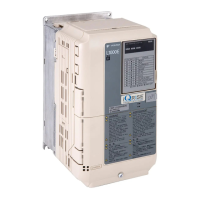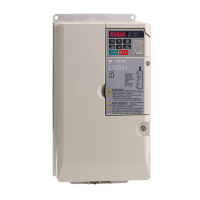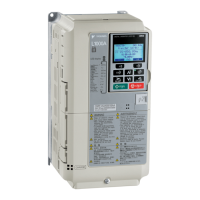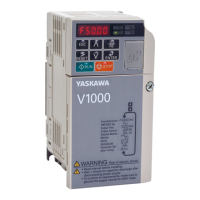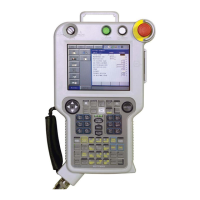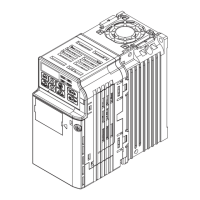6.3 Fault Detection
294 YASKAWA ELECTRIC SIEP C710616 38F YASKAWA AC Drive - L1000A Technical Manual
Digital Operator Display Fault Name
oH4
Motor Overheat Fault (PTC thermistor input)
• The motor overheat signal to analog input terminal A1 or A2 exceeded the fault detection level.
• Detection requires that multi-function analog input H3-02 or H3-10 = “E”.
Cause Possible Solution
Motor thermostat wiring is fault (PTC thermistor input). Repair the PTC thermistor input wiring.
There is a fault on the machine side (e.g., the machine is
locked up).
• Check the status of the machine.
• Remove the cause of the fault.
Motor has overheated.
• Check the size of the load, the accel/decel times, and the cycle times.
• Decrease the load.
• Increase the acceleration and deceleration times (C1-01 through C1-08).
Adjust the preset V/f pattern (E1-04 through E1-10). This will mainly involve reducing E1-08 and E1-10. Be careful not to lower
E1-08 and E1-10 too much because this reduces load tolerance at low speeds.
• Check the motor rated current.
• Enter the motor rated current as indicated on the motor nameplate (E2-01).
• Ensure the motor cooling system is operating normally.
• Repair or replace the motor cooling system.
Digital Operator Display Fault Name
oL1
Motor Overload
The electronic motor overload protection tripped.
Cause Possible Solution
Load is too heavy.
Reduce the load.
Note: After the value of U4-16 has decreased to one less than 100, reset oL1. The value of U4-16 must be less than 100 before
oL1 can be reset.
Cycle times are too short during acceleration and
deceleration.
Increase the acceleration and deceleration times (C1-01 through C1-08).
A general purpose motor is driven below the rated speed
with too high load.
• Reduce the load.
• Increase the speed.
• If the motor is supposed to operate at low speeds, either increase the motor capacity or use a motor specifically designed to
operate in the desired speed range.
The output voltage is too high.
• Adjust the user-set V/f pattern (E1-04 through E1-10) by reducing E1-08 and E1-10.
• Do not set E1-08 and E1-10 too low. This reduces load tolerance at low speeds.
The wrong motor rated current is set to E2-01.
• Check the motor-rated current.
• Enter the value written on the motor nameplate to parameter E2-01.
The Base Frequency is set incorrectly.
• Check the rated frequency indicated on the motor nameplate.
• Enter the rated frequency to E1-06 (Base Frequency).
Multiple motors are running off the same drive. Disable the motor protection function (L1-01 = 0) and install a thermal relay to each motor.
The electrical thermal protection characteristics and
motor overload characteristics do not match.
• Check the motor characteristics.
• Correct the type of motor protection that has been selected (L1-01).
• Install an external thermal relay.
The electrical thermal relay is operating at the wrong
level.
• Check the current rating listed on the motor nameplate.
• Check the value set for the motor rated current (E2-01).
Output current fluctuation due to power supply loss Check the power supply for phase loss.
Digital Operator Display Fault Name
oL2
Drive Overload
The thermal sensor of the drive triggered overload protection.
Cause Possible Solution
Load is too heavy. Reduce the load.
Accel/decel ramp is too short. Increase the settings for the acceleration and deceleration times (C1-01 through C1-08).
The output voltage is too high.
• Adjust the preset V/f pattern (E1-04 through E1-10) by reducing E1-08 and E1-10.
• Do not lower E1-08 and E1-10 excessively. This reduces load tolerance at low speeds.
Drive capacity is too small. Replace the drive with a larger model.
Overload occurred when operating at low speeds.
• Reduce the load when operating at low speeds.
• Replace the drive with a model that is one frame size larger.
• Lower the carrier frequency (C6-03).
Excessive torque compensation. Reduce the torque compensation gain (C4-01) until there is no speed loss but less current.
Output current fluctuation due to input phase loss Check the power supply for phase loss.
Digital Operator Display Fault Name
oL3
Overtorque Detection 1
The current has exceeded the value set for torque detection (L6-02) for longer than the allowable time (L6-03).
Cause Possible Solution
Parameter settings are not appropriate for the load. Check the settings of parameters L6-02 and L6-03.
Fault on the machine side (e.g., machine is locked up). Check the status of the load. Remove the cause of the fault.
Digital Operator Display Fault Name
oL4
Overtorque Detection 2
The current has exceeded the value set for Overtorque Detection 2 (L6-05) for longer than the allowable time (L6-06).
Cause Possible Solution
Parameter settings are not appropriate for the load. Check the settings of parameters L6-05 and L6-06.
SIEP_C710616_38F_5_0.book 294 ページ 2015年11月9日 月曜日 午後3時36分

